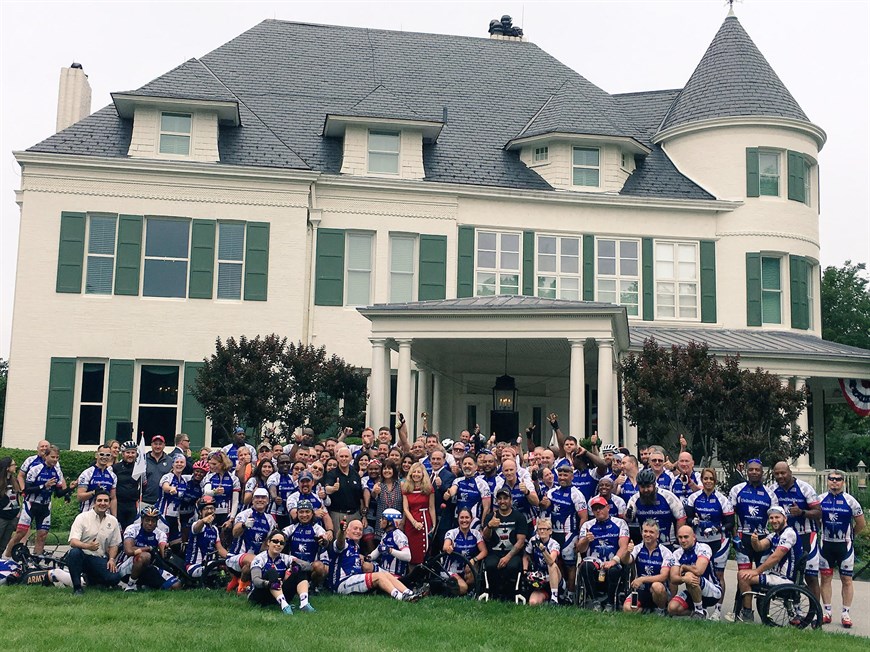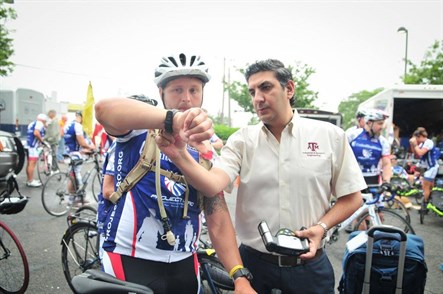
When he began working on an algorithm-based monitoring system to help veterans suffering from post-traumatic stress disorder (PTSD) Dr. Farzan Sasangohar didn’t imagine he’d wind up talking about the technology with the vice president of the United States.
Sasangohar, assistant professor in the Department of Industrial and Systems Engineering at Texas A&M University, was just looking for ways to get his research to people who could benefit from it, which led to a partnership with Project Hero, a nonprofit organization that helps veterans and first responders affected by injury, post-traumatic stress disorder and traumatic brain injury, to achieve rehabilitation, recovery and resilience in their daily lives.
 Their partnership, called Hero Trak, is a monitoring system that can help veterans with PTSD. They debuted Hero Trak in April at the UnitedHealthcare Texas Challenge, and it is being tested again this week at the UnitedHealthcare Memorial Challenge event, which began in Washington D.C. at the vice president’s residence.
Their partnership, called Hero Trak, is a monitoring system that can help veterans with PTSD. They debuted Hero Trak in April at the UnitedHealthcare Texas Challenge, and it is being tested again this week at the UnitedHealthcare Memorial Challenge event, which began in Washington D.C. at the vice president’s residence.
Sasangohar showed Hero Trak to Vice President Mike Pence and his wife Karen, as well as Veterans Affairs Secretary David J. Shulkin and Dr. Poonam Alaigh, the acting undersecretary of health for the Department of Veterans Affairs.
“The vice president, second lady and Secretary Shulkin interacted with the system and were enthusiastic about the potential for the technology to help veterans, and expressed support to facilitate future research in this domain," Sasangohar said.
 At the UnitedHealthcare Texas Challenge last month, more than 100 wounded veterans and supporters biked more than 500 miles from San Antonio to Waco to Houston. Thirty-one of them were wearing monitoring devices, and after the event the data from those devices were collected by Sasangohar. The feedback from the event was overwhelmingly positive.
At the UnitedHealthcare Texas Challenge last month, more than 100 wounded veterans and supporters biked more than 500 miles from San Antonio to Waco to Houston. Thirty-one of them were wearing monitoring devices, and after the event the data from those devices were collected by Sasangohar. The feedback from the event was overwhelmingly positive.
"The work done by Texas A&M under the leadership of Dr. Sasangohar has helped create a truly elegant and effective solution to the acute problem faced by our veterans and first responders of dealing with PTSD in their daily lives," said John Wordin, founder and president of Project Hero.
"Our riders who have used the HERO Trak system see it as more than just an accurate and convenient way to track, identify and deal with PTSD triggers -- which all of them do -- they also see it as an important step in the use of technology to address the needs of millions of patients like themselves for improved outcomes at lower costs, which is the core mission of Project Hero."
“There’s only so much you can do in the lab space,” Sasangohar said. “At some point you have to take these devices out and do naturalistic studies. This was an opportunity because we had a group of veterans and first responders with PTSD who are actually motivated to participate and they’re performing some sort of physical activity.”
 Currently, interaction with patients suffering from PTSD is mostly limited to in-person sessions. However, Sasangohar’s hope is that down the road, technology will be able to identify PTSD issues.
Currently, interaction with patients suffering from PTSD is mostly limited to in-person sessions. However, Sasangohar’s hope is that down the road, technology will be able to identify PTSD issues.
The devices themselves are off-the-shelf Motorola 360 smart watches, but it’s in the analysis where Sasangohar’s work takes place. Using advanced algorithms, the technology identifies when someone might be having the arousal symptoms of PTSD.
The difficult part is deciphering symptoms of PTSD, like an elevated heart rate, from regular physical activity. That’s where the partnership with Project Hero is already showing tremendous value.
“We have access to their biometric data to be able to validate our algorithms to see if they can pick up those activities,” Sasangohar said. “And these are people that are motivated to help; we can ask them to self-report the PTSD triggers they experience.”
They built the app so that it not only collected data, but also worked as a self-reporting device. For example, the riders could tap the screen to indicate whether or not they were experiencing a PTSD trigger.
One goal of the research is to be able to intervene during a PTSD occurrence. The wearer might be guided through some breathing exercises for example. Or if the system detects a PTSD episode is happening while the wearer is asleep, the device could gently wake them up by vibrating.
“The amount of PTSD triggers that happen during sleep is unbelievable,” Sasangohar said. “The heart rate can rapidly increase and can stay there for 20 minutes, so they’re having these long nightmares; we have objective data showing that. And these are very intense nightmares. If you wake up suddenly startled, you can be in that zone for a few minutes where you don’t fully know where you are. What if we could intervene and gently wake someone up that’s experiencing that?”
Sasangohar said he was also overwhelmed with the feedback he received from the participants.
“They all came to me when I was collecting the data and it seems like they appreciate this technology,” he said. “They had so much positive feedback and offered to help more and participate in future interviews or studies. Some were very emotional, saying thank you for helping us. It was emotional seeing people pick up these devices and appreciate what we’re trying to do with this technology.”
Sasangohar’s research extends beyond PTSD applications. Currently his research group is testing smart monitoring and intervention applications in surgery, nursing and other fields. He has received a Texas A&M iSITE grant to participate in the summer 2017 Texas A&M cohort, funded by the National Science Foundation. The program explores the potential commercial potential for his tool “Remote Monitoring and Intervention for PTSD Patients.” His iSITE team includes industrial and systems engineering doctoral students Kunal Khanade and Carolina Rodriguez-Paras.